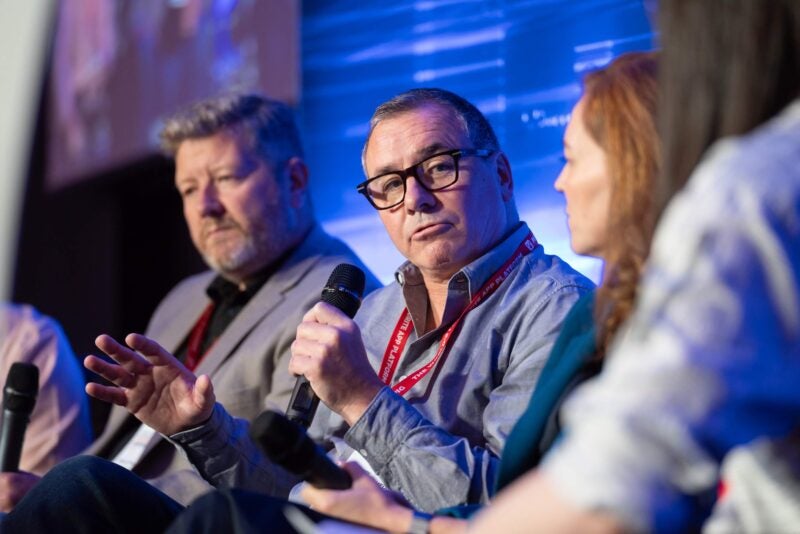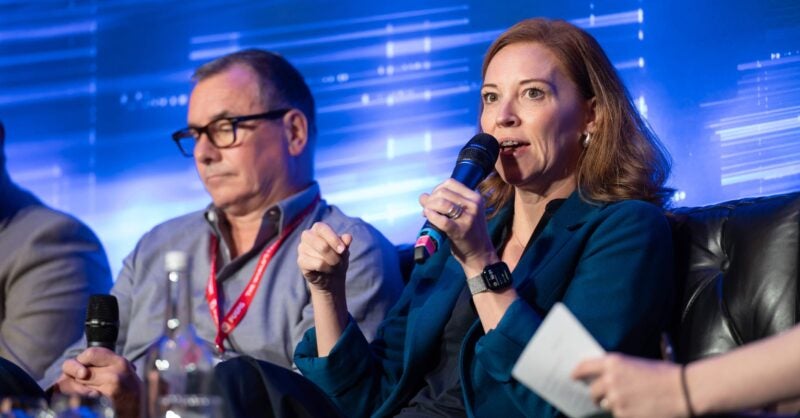
Financial Times managing director, consumer revenue Fiona Spooner speaking at the Future of Media Technology Conference on 11 September 2025. Picture: ASV Photography for Press Gazette
The Financial Times has increased subscription conversion rates by almost 300% by personalising the paywall messaging and offers people see depending on their past activity and preferences.
However, when it comes to editorial content, the FT is focused on “tailored experiences” created by human editors rather than AI-personalised feeds.
Fiona Spooner, managing director of consumer revenue at the FT, said this was because “you don’t want to lose the serendipity that comes with editorial influence”.
Spooner was speaking on a panel about reader data at Press Gazette’s Future of Media Technology Conference in London on 11 September alongside leaders from Reach, The Independent and publisher software company Full Fat Things.
The FT reported 1.35 million digital subscribers in its latest financial results, up from 1.28m in 2023.
Spooner addressed the experience of FT Edit, an app launched in 2022 that offers a curated eight FT articles a day for a much lower price (£4.99 per month) than a full subscription to the newsbrand (from £279 for the first year).
Spooner was asked whether the FT might use AI to choose the eight articles each user would most appreciate rather than eight chosen by the editorial team for all users.
She said common feedback from FT Edit users is both that “they love the serendipity of the Edit” and “how do I get a version for me?”
“So it’s something we are looking at at the moment,” she said. “We’ve got a big piece of work around our price and propositions, going back to what each audience needs and where our growth opportunities are, and we work really closely with editorial.
“That’s a great relationship we’ve got with them, and they are absolutely open to using AI, not about content, but about making better customer experiences and providing value to our audiences.”
Where the FT does use personalise is in its AI-powered paywall, which launched last year.
Spooner explained that with products like FT Edit, subscription-based newsletters and standard/premium digital/print bundles, the FT has “more products than sometimes people imagine”.
She said it was therefore important to “get the right product to the right person for the right price”.
With the new technology, she said, “we’ve been able to really make that much more personalised, because we know about demographic data, behavioural data, how many times they’ve hit the paywall, where they are, whether or not they’re a lapsed subscriber, ingesting all of that and being able to put the right product in front of people using AI and having different creatives depending on the news agenda as well.
“And that’s increased conversion by about 280%, and lifetime value by 7% so that’s been a really big win for us, and now we’re building that on the retention side too, so making sure, again, while people are thinking about maybe cancelling or postponing their subscription, that we’re able to use that data to say, actually, have you signed up to this newsletter? Do you know that we’ve also got the Edit? And tailoring the next best offer that we put in front of them, using the same capabilities and those tailored experiences to show that we understand who they are, what they need from us, what they value, and make it feel like we know them, and it’s more personalised.”
Full Fat Things managing director Stewart Robinson backed this approach for B2C publishers, saying that “making the paywall more available to the person who’s there, rather than just some sort of blanket rule and reacting to whether ad markets are doing well” was working for his customers.
But overall he said he is “much less worried than other people in the industry about radicalising by automatically showing people more of what you want, because you’re only showing them your own content. It’s very different from showing them social media content or Youtube content where it’s been produced by the masses.”
 Stewart Robinson, managing director of Full Fat Things, speaking at the Future of Media Technology Conference on 11 September 2025. Picture: ASV Photography for Press Gazette
Stewart Robinson, managing director of Full Fat Things, speaking at the Future of Media Technology Conference on 11 September 2025. Picture: ASV Photography for Press Gazette
Meanwhile, the best B2B publishers are “trying to build habits where they can slowly collect more real information actually inputted by customers, giving them more information about themselves, slowly, without having to collect it all up front”, he said.
This means they are “moving upmarket more towards doing lead generation and highly specific products”.
Personalisation ‘heavily used’ by Reach to turn fly-by users into loyal audiences
Mark Edwards, group digital director at Reach, said personalisation is a balance to be struck for the publisher of titles like the Mirror, Express, Manchester Evening News and Liverpool Echo.
He said they have “dabbled” in personalising what people see on homepages and landing pages but they “don’t do too much in there at the moment”.
Edwards said they are “not against it, and there’s value there, but you have to strike that balance between showing users what they want, or what you think they want, and enabling that discovery.
“If you’ve got a large breadth of journalism and things like news and stuff like that, you don’t want to pigeonhole users into a specific area.”
 Reach group digital director Mark Edwards speaking at the Future of Media Technology Conference on 11 September 2025. Picture: ASV Photography for Press Gazette
Reach group digital director Mark Edwards speaking at the Future of Media Technology Conference on 11 September 2025. Picture: ASV Photography for Press Gazette
However, Reach does do a lot of personalising content recommendations that appear on article pages to try and keep people on site for longer.
Edwards said: “We’ve got lots of tools that we’ve built in-house that use user data, contextual signals, to try and figure out what’s the most likely article that that user will want to hit next.
“And that’s very important for us, because a lot of our traffic is search and social. We have fly-by users. So it’s important to figure out how to turn those users into loyal, secure, whatever you want to call them, audiences. So personalisation is very heavily used on that front for us.”
Personalised experiences ‘driving The Independent’s future’
Andy Morley, chief revenue officer at The Independent, said “understanding and delivering more personalised experiences” is “definitely how we’re driving towards our future”.
This is partly why The Independent launched its AI-powered Bulletin product this year, he said, which summarises Independent articles into bullet points.
[Read more: Revenue for Independent tops £50m for first time since digital rebirth]
Morley said The Independent publishes some “pretty heavy” but quality longer reads, and that they “knew that there was an appetite for shorter reads, more punchy news reportage”.
He described Bulletin as “effectively an Independent digest, which is written by our journalists, but effectively curated and subbed by AI” and said it has “actually generated jobs because it’s creating so much more content for us and just giving us new audiences who’ve got less time to spend on the content, but still want the information delivered by us”.
 The Independent’s chief revenue officer Andy Morley speaking at the Future of Media Technology Conference on 11 September 2025. Picture: ASV Photography for Press Gazette
The Independent’s chief revenue officer Andy Morley speaking at the Future of Media Technology Conference on 11 September 2025. Picture: ASV Photography for Press Gazette
Morley noted that The Independent has “three broad cohorts” of users.
It has a “relatively small subscription business” but said those people are “highly valuable”.
The Independent charges £4 per month for people to see an ad-free website, opting out of personalisation or tracking, under the growing “consent or pay” model increasingly being adopted by big and small publishers.
“Because of consent and pay we’ve got a lot of user data for a sort of softer reg gate,” Morley said.
“And then anyone else that’s left, I’m just going to pepper them with as many ads as I can get away with.”
Email pged@pressgazette.co.uk to point out mistakes, provide story tips or send in a letter for publication on our “Letters Page” blog

